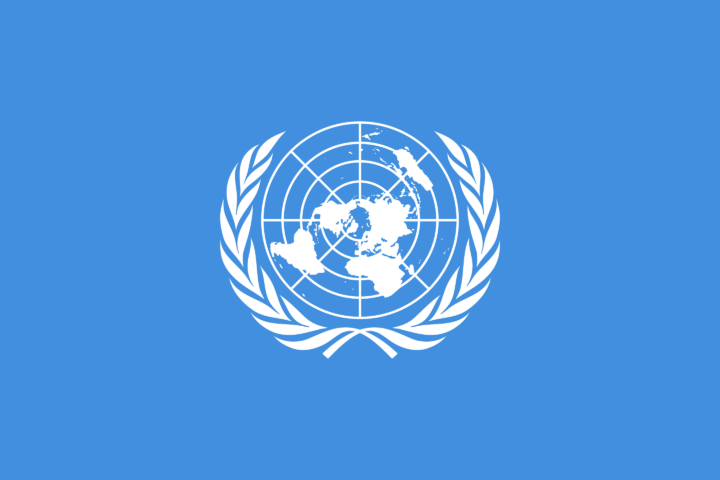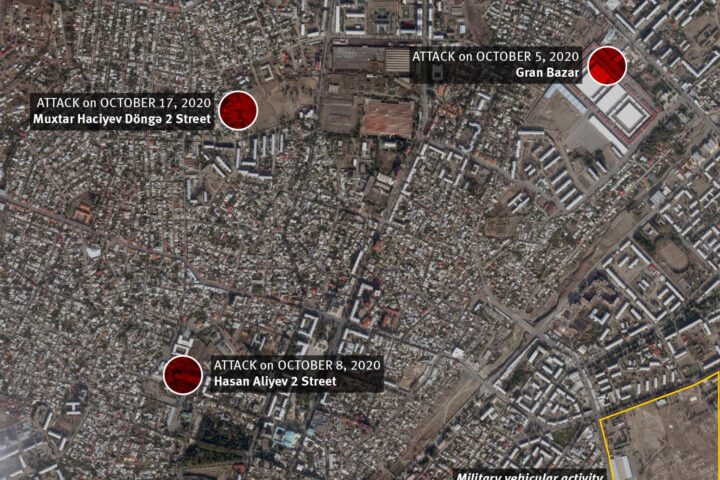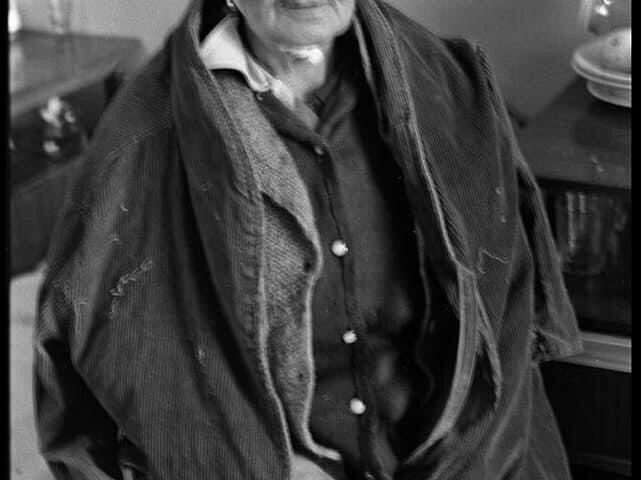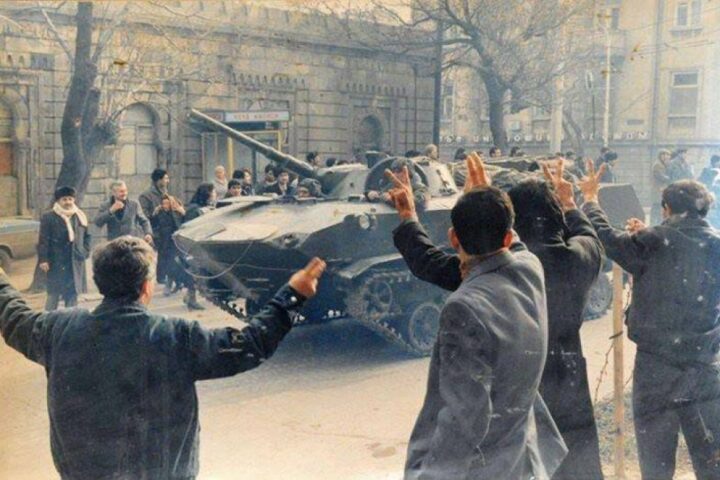THE LEVELS OF THE KARABAKH CONFLICT: FROM LOCAL TO GLOBAL SCALE
Since the time of entering the USSR the multinational Azerbaijan had already had its own ethnic problems, but only one of them developed into a full-scale war with the Armenian population of Nagorno Karabakh and Armenia for NK. According to the statistics, Armenians made up 70-75 % of NK’s population (150-160 thousand people), living in an enclave inside Azerbaijan. As a result of this confrontation the “freedom” of Karabakh Armenians cost the lives of tens of thousands of people on both sides, a forced resettlement of 250,000 Azeris from Armenia and 400,000 Armenians from Azerbaijan, a seizure of seven more regions of Azerbaijan outside the enclave of NK, which caused the emergence of 800,000 refugees and forcibly displaced persons in their own country. The Azerbaijan Republic claims that 20% of its territory is occupied by the Republic of Armenia1.
Armenia deems that it was the result of the struggle of the Defense Army of the unrecognized Nagorno Karabakh Republic (NKR) against the 7-million Azerbaijani Republic and, consequently, it is Azerbaijan’s internal affair, although the enclave of NK turned into a territory united with the Republic of Armenia almost all along the state frontier between the two countries2.
For the further presentation of the material it useful to get an idea of what can conventionally be called “the levels” of the conflict. Their importance arises from the fact that transitions from one level to another substantially changed the nature of the confrontation and ways of solving the problem3. Chronologically, the dynamics of the Karabakh conflict can be presented by the following scheme.
1.Ethnic-confessional level:Azeris – Armenians.
2.Regional level:Azerbaijan – Karabakh – Armenia.
3.Soviet – post-Soviet level:Azerbaijan – USSR (Russia, RF) – Armenia
4.International level:Azerbaijan – Armenia and others states (the most important of them are the United States, Russia, EU countries, Turkey, Iran).
We think it necessary to analyze these levels separately before passing on to the analysis of possible variants of stabilization, and then to address the ways of solving the conflict.
1. The ethnic level of the conflict
The radical distinction of ethnic-confessional self-identification of the Azeris and the Armenians is obvious, although sometimes, whoever paradoxical it may sound, it turns into likeness. The Azeris refer themselves to the large community of Muslims and to the smaller, but still considerable community of Turks. The Azeris consider themselves to be a large nation and are practically not concerned over the problem of ethnic survival and its possible extinction. The Azeris are mostly Shi’ites, which puts them in a special position in the Muslim world in general and in an almost exceptional position in the Turkic world. Armenians, belonging to the large community of Christians, due to their confessional specificity hold a special place among them (and they conceive the fact). They regard themselves as a unique ethnic group. Owing to the long period of their life in the surroundings of non-Christian culture and historical collisions, Armenians have developed a persistent sense of a constant threat of extinction as “a small ethnic group in conditions of hostile surroundings”. It seems that this element of Armenian mentality played an important role in the development of this conflict, and, furthermore, it plays a significant role at the present stage. In particular, it adds to the distrust towards the assurances of the Azeri side about providing guaranties of security to the Armenians of NK.
During the years of the Soviet system both peoples lost their spirit of religion. As a result, Islam and, correspondingly, Christianity, turned into a form of everyday religion. Nevertheless, the Armenians retained their perception of religion as a factor of consolidation of the people, and of the church as an institution of self-government and social organization (the Armenian Apostolic Church indeed played this role during the centuries when Armenia held no statehood).
At the same time, the closeness of these two people appears to have much deeper roots than the 70 years of life in approximately similar conditions of the Soviet regime (let alone the earlier historical periods). Thus, the historical situation has repeatedly promoted in both cases the de-ethnisization of some strata of these peoples. The “ethnic-genetic material” of native Albanians was mainly shared by these two ethnos. After all, the long period of habitation side by side resulted in a great number of mixed marriages leading to a marginalization of both ethnos. It is a striking fact that the closeness of the Georgians and the Armenians by all accounts should have been greater than that of the Armenians and the Azeris, but a great many of historical-cultural facts and regularities prove the opposite. This fact found its most vivid reflection in places, usually in provinces, where representatives of the two peoples lived together and formed a peculiar symbiosis. The Azeris always distinguished “our” and “foreign” Armenians, and “our” Armenians (“from Karabakh”) (from the Azeris’ point of view) always opposed themselves to “Yerevanians”. That is why it was possible to speak about several “Azeri” (“Baku”, “Armenian”, “Georgian”, etc.) and “Armenian” (“Karabakh”, “Yerevanian”, “Diasporan”) mentality towards “neighbors” and “history”. The inverted comas in either case mean that all these spheres are quite mythologized, saturated with unconscious and subconscious motives and saturated with “facts”. The historical myths and the shift of responsibility from one ethnic group (people) to the other never lost ground.
However, the experience of conflict in the inter-relations between the Armenians and the Azeris in the region had begun approximately since the middle of the 19th century. It continued with bloody confrontations of 1905, 1918 and the following years up until the contemporary events, when the sides again showed a tendency toward mutual annihilation, and crossed the threshold of humanity, like the Serbs and Croats did at their time. The attempts to identify the opposing side as “barbarians” were expressed in numerous phobias, in the fright of each other, in the formation of an image of the enemy, and in the conversion of subconscious phantoms into reality. Two components of the forming elite – intellectuals and religious figures, devoid of the experience of democracy, played a negative role, and the decisive role of “revolutionary anarchy” was exercised by the “newly arrived” bellicose elements. It was in that environment that there emerged the idea of a genocide of Azeris, or claims for the so-called Western Azerbaijan (as some Azeri politicians name the modern Republic of Armenia) in response to the Armenian claims for Karabakh and Nakhichevan (Nakhchyvan after changing the writing of the names of a number of cities and towns in Russian in Azerbaijan).
One of the ways out of the deadlocks of consciousness is seen in the modeling in the region those principles of joint Diaspora life of Armenians and Azeris that was formed in Russia and where their cooperation is seldom burdened by “the idols of the past and the present”. The possibilities of destroying the myths also proceed from the processes of democratization that bring transparency into the social, political and economic spheres of public life.
2. The regional level of the conflict
The Karabakh conflict became a factor in the (early or late) formation of the new national elites claiming political power in Azerbaijan, Armenia and even in the NK. The path to power was possible only by riding the wave of nationalism. It is a mistake to think that the Baltic states witnessed a democratic, liberal breakthrough, however. There, too, everything was happening on the wave of nationalism, but that was consolidated by the Baltic republics and targeted with solidarity directed against the outside, against the USSR. This didn’t take place in the South Caucasus. The different attitudes of the three republics to the search for an external reference-point, their constant shifts from position to position, and Georgia’s and the Azerbaijan Republic’s late accession to the CIS moved apart their expectations and results.
The leaders of the Azerbaijan Republic and the Republic of Armenia have forever become hostages to the nationalist slogan and sentiments, and not only because of necessity, but also proceeding from the fact that the prolongation of the conflict was, and is, an indispensable condition of retaining personal power. (The only exception, the case with the first President of the Republic of Armenia Levon Ter-Petrosyan, only confirms what was said above). The fact that the politically active masses and leaders were mainly mobilised from the peasantry led to a modification of the psychology and logic of the political situation and its analysis. The leaders of Armenia and Azerbaijan, Robert Kocharyan and Heydar Aliyev, relied on certain forces (of a “Diasporan” character) and had to curry their favor and support. Meanwhile, the hard and cruel period of the primary accumulation of capital had already ended in the republics and brought the capital under the control of narrow groups (“clans”) of people tied to each other. In such a situation, an urgent need for a certain “new way of thinking” appeared among the political elites of Azerbaijan and Armenia, but there was not enough time for that. Time will show if the formation of such a new approach may demand a change in the present political elites and their leaders (Ilham Aliyev, who replaced his father in 2003, still declares the need for a continuation of the policy and trust toward the team of his father, which, however, is unlikely at least because of the changed situation in the region4). The following question first of all arises: may a change of elites in the Republic of Armenia and the Azerbaijan Republic destabilize the situation in the region even more? The events in Georgia in late 2003 showed that these processes may begin in an absolutely “unexpected” way.
Georgia, which could have assumed the task of consolidating the region (and forming that very “new way of thinking”), itself has been buried under the burden of its own problems, including ethnic conflicts. The impossibility of a Tripartite Alliance in the South Caucasus today bears a striking resemblance to the situation that existed at the beginning of the 20th century when all three republics obtained short-lived independence. Also the sentiments of the NK population should not be underestimated. For more than 10 years the Armenians of the NK, like the Abkhazians, have de facto lived without any submission to another state, and this fact reflects on their mentality and turns them into a separate factor in the political situation of the region – something that outside forces5often make use of.
It is obvious that the development of civil societies and institutions, and the strengthening of democracy in general, are a necessary (but not sufficient) precondition for an ultimate resolution of the conflict and reconciliation between the two peoples. The formation of civil unions and structures directing their activities at the consolidation of democratic processes in the three republics and the formation of an intellectual forum of the South-Caucasian countries are major factors in these processes. The search for a common model to resolve the numerous conflicts in the republics of the region, the analysis of the problem of ethnic homogeneity and its different representations in the republics of the South Caucasus, setting up Russian, American and European forums of the peoples of the South Caucasus (as a significant part of population has migrated to all countries worldwide), for example, and coordination of their actions are potentially important activities in reducing the level of tension in the region.
The Soviet-post-Soviet level of the Nagorno Karabakh conflict
[no_toc]










